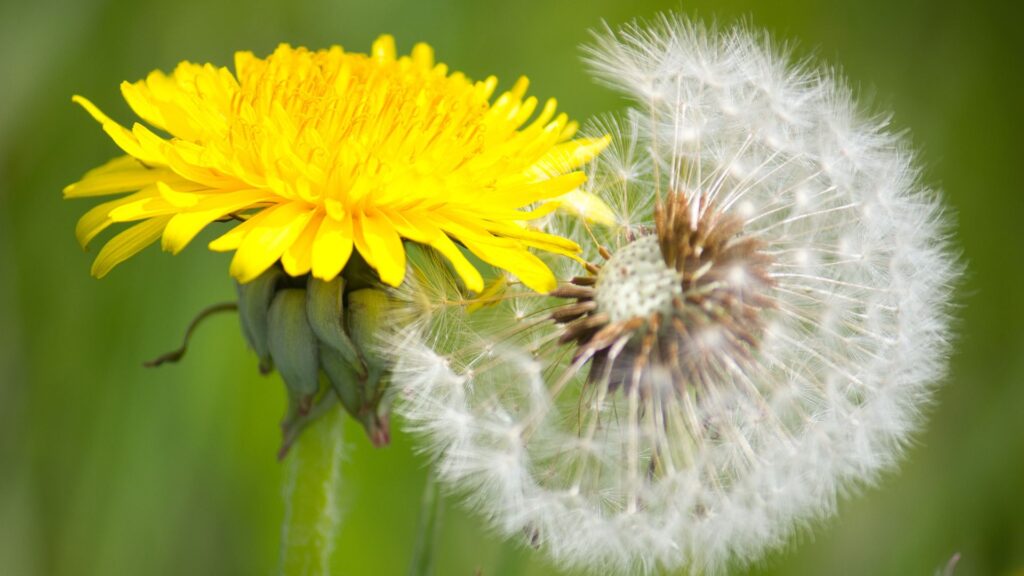By Carol Sitarski, Master Gardener Volunteer Cornell Cooperative Extension Allegany County
How did the humble dandelion, often seen as a pesky weed, come to hold such a fascinating and multifaceted role in our environment and culture? Let’s learn a couple of facts that probably you didn’t know about this plant.
Dandelion got its name from the French word “Dent de lion” as the leaves resemble a lion’s teeth. Originally from Eurasia, it is believed to have been brought to the Americas on the Mayflower with the pilgrims. There are approximately 250 different varieties throughout the world, mostly with yellow flowers but there is a pink and a white flower variety in Europe. In the Northeast there are two varieties: Taraxacum officinale and Taraxacum erythrospermum, or red-seeded dandelion as the seed base is a reddish-brown color.
Both grow from a basil rosette with a thick long taproot and yellow flowers. The leaves are 3-10 inches long and have a few crinkled hairs on the upper and lower surfaces, which have widely spaced teeth that point toward the leaf base. The leaves, taproot, and flower stem which is hollow, all exclude a white milky juice when cut. The yellow flowers appear from May to June and sometimes in Autumn. It reproduces from windblown seeds and through vegetative regrowth of the taproot. The seed heads look like little feathery balls.

Of course, we have come to the subject everyone is most interested in: how to control or manage it. There are several practices you need to learn. Of course, they are a wonderful benefit to pollinators of all kinds, but they can be naturally controlled. The use of harmful herbicides is not needed when you follow these suggestions.
- The use of vinegar solutions won’t work. Regular white vinegar only has a 5% acetic acid which may kill upper vegetation but not the roots. What you need is horticultural vinegar with a 20% acetic acid which is very potent and needs to be handled by professionals only. Regular vinegar mixed with things such as dish detergent or Epsom salts can cause harm to the soil pH. Epsom salts are magnesium sulfide which can act as a fertilizer.
- Avoid using fertilizers high in potassium (K) and use lime as this acts as fertilizers for the dandelions.
- Have your soil tested every few years at your local Co-operative Extension office for a small fee.
- Mowing your lawn when flowers appear and not waiting until seed heads appear as this will disperse them more.
- Removing the taproot is the best method but it needs to be completely removed or it can regrow. There are several tools for this, such as a stand-up puller, garden knife, or dandelion puller. The best time to do this is after raining when the soil is damp or watering the area before doing this.
I found a technique that I tried and really worked. Using your dandelion weeder tool (it looks like a flat-head screwdriver, but its head has a V shape to cut the taproot), insert it slightly above the plant base at 12 o’clock all the way down into the soil, pushing the handle away from you, loosening the soil. Repeat this step for the positions 3 o’clock, 6 o’clock, and 9 o’clock, always pushing the tool all the way into the soil, then pushing the handle sideways away from the plant, so slowly you will be pulling that taproot up and you can easily remove it by hand, it should come out pretty easy. My favorite joke about weeding “It’s like pulling off a pest’s head but leaving the spine attached.”
But not everything is bad about the humble dandelion. So, what is good about them? Well, for one thing, the cheery yellow flowers are like eye candy after a long, cold, dreary winter. They provide needed nutrition to numerous pollinators. Dandelions have been used for over 2,000 years for medicinal purposes. In fact, the whole plant can be used for either food or medicine. Flowers make a wonderful jelly or wine, leaves can be used in salads or sautéed (best eaten young), and taproot is used for various medical conditions or health reasons.
So, a dandelion may be a weed but remember “A weed is only a plant growing in the wrong place.”, so maybe is not so bad after all!
Here you can find more information and interesting research-based facts about dandelions:
Cornell University, dandelion: https:cornell.edu/weedid/dandelion How to control dandelion naturally: https://extension.oregonstate.edu/ask-extension/featured/how-can-i-naturally-kill-dandelions
Backyard biodiversity: dandelions: https://biodiversity.utexas.edu/news/entry/backyard-biodiversity-dandelions
If you want to learn about weed control and many other gardening topics, visit Cornell Cooperative Extension website and read more articles from our Master Gardener Volunteers here: https://allegany.cce.cornell.edu/gardening/master-gardener-blog










